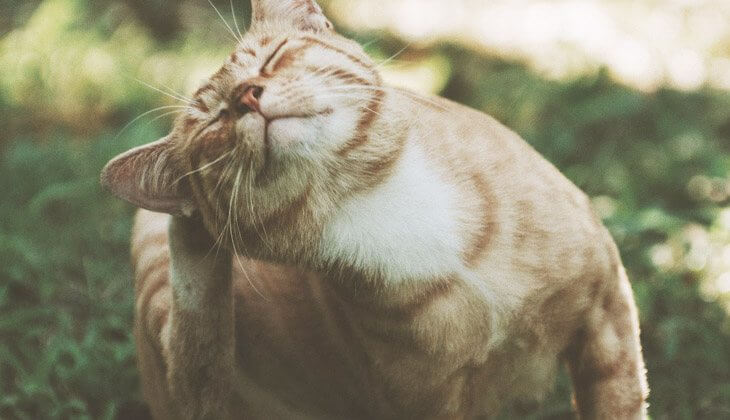Wondering How To Tell If Your Cat Has Fleas? Here Are 9 Signs
HEALTH & PROTECTION
10 Jul, 2019
READ 7 minutes

No doubt, cats are probably one of the cleanest creatures on earth. If you’ve ever watched your cat groom, then you know it can do this for what seems like hours on end. Most cats spend 10% of their waking hours grooming their fur. Although you may think that all of this grooming will help your cat steer clear of one of the peskiest parasites on the planet—the flea —it will not.
Believe it or not, cats are twice as prone as dogs to fleas, it’s just that the cat’s meticulous grooming habits make fleas much harder to spot.
Indoor cats are not much safer than outdoor cats in this respect because fleas can enter your home on unsuspecting visitors or their pets. If you’re wondering how you know if your cat has fleas then read on—here are nine signs that your cat may be hosting unwanted guests in your home.

1. YOUR CAT BEGINS TO GROOM EXCESSIVELY
One of the first signs that your cat has fleas is a change in grooming habits. You may notice that grooming becomes more like an extreme sport than a relaxing pastime for your cat. Your cat, a master when it comes to self-care, is no match for a team of fleas.
Excessive grooming, along with licking, chewing scratching or biting, often leads to an increase in hair loss and sometimes bald spots on the back of your cat’s legs, neck or tail base. So if you detect even the slightest change in your cat’s meticulous behavior, take a closer look at its skin to see if you can discover evidence of any fleas.
2. YOUR CAT DEVELOPS RED SKIN LESIONS OR SCAB-LIKE BUMPS
When a flea bites your cat, the flea’s mouthparts pierce its skin like a needle to feed. The saliva the flea injects into your cat may cause an allergic reaction. In some cats the response is subtle, but in others it is severe, and the skin becomes red and inflamed. If you notice red skin lesions or scab-like bumps it is essential to seek help from a veterinarian to reduce inflammation and prevent infection.
3. YOUR CAT BECOMES WEAK, OR ITS GUMS BECOME PALE
In extreme cases, a cat can lose so much blood from a heavy flea infestation anaemia develops. This is more commonly a problem in young kittens but if the infestation is big enough any age of cat can be affected. If your cat seems to be off colour make sure it receives immediate veterinary care
4. YOUR CAT BEGINS LOSING WEIGHT
One of the many dangers associated with fleas is that they can carry the developing stage of a common tapeworm. If your cat eats a tapeworm-infected flea while grooming, the tapeworm develops, and attaches to your cat’s intestinal wall to feed and grow. Tapeworms do not commonly cause signs of illness in cats but are unsightly and a health hazard, particularly if you have young children in your home. Your veterinary team can help you control the fleas that are spreading the tapeworm and treat the tapeworm to keep you, your cat and the rest of your family healthy.

5. YOUR CAT SUDDENLY AVOIDS CERTAIN PARTS OF YOUR HOME
Fleas tend to thrive in areas that are between 65-80 ℉ (18-27 ℃ )with humidity levels between 75-80%. Although that may sound like conditions you’ll find outside in warm weather, those are also conditions you’ll find inside your home year round. Flea eggs and larvae are often found in carpeting, under skirting boards and in soft furnishings. So take note and take heed. It’s important to vacuum thoroughly on a regular basis and make sure that you empty the vacuum so the fleas don’t thrive there. If you find fleas, be sure to wash your cat’s bedding with detergent in hot water. Flea pupae can lie dormant for months. The only thing that can get rid of fleas is flea control that provides extended protection.
6. YOUR CAT BECOMES ANXIOUS
Fleas can drive anyone crazy, especially the animal they are attacking. The constant biting and the resulting itch and irritation may cause a severe shift in your cat’s otherwise pleasant and peaceful demeanor. If you notice your cat becoming increasingly aggressive, irritable, upset or frantic, fleas may be the cause. Take a closer look at your cat’s fur and skin and seek the care of and advice from your veterinarian.
7. YOU NOTICE TINY PEPPER-LIKE SPECKS IN THE FUR
These specks may be flea dirt. It’s one of the most common signs that your cat has fleas. When a flea bites your cat, the faeces from the digested blood will appear on your cat’s fur or a comb or brush. If you notice these tiny, pepper-like specks, take a sample, place it on a white paper towel or cloth and mist it with water. If the sample turns red, it is likely flea dirt. Consult your veterinary team for advice to manage flea infestations in your home.
8. YOU DETECT DARK PEPPER-LIKE SPECKS IN YOUR CAT’S BEDDING FABRIC
It’s flea dirt again! If you notice this on your cat’s bedding or furniture, consult your veterinarian to find out what steps should be taken to get rid of fleas and keep them out of your home.

9. YOU SEE PINHEAD-SIZED BLACK OR REDDISH-BROWN INSECTS CRAWLING IN YOUR CAT’S FUR
If you see this, you’re looking at the fleas themselves! If your cat is suffering from a heavy flea infestation, you may be able to see fleas or flea dirt in their fur. These are usually rapidly moving. You can check your cat’s fur for fleas by checking the skin after parting the hair. Fleas tend to gravitate towards lower back, hind legs, and stomach so be sure to check these areas carefully.
If you notice any of these signs on your cat, you should consult your veterinarian to rule out fleas.
If your cat does have fleas, your veterinarian can recommend treatment options. It’s important to know that fleas are remarkably resilient little pests, their pupae can stay dormant for months before hatching and latching onto your pet or other family members and restarting their entire life cycle all over again. To eliminate fleas you need to treat with an effective option for at least 3 months without any gaps in treatment. Three-month protection is ideal for eliminating not only present fleas but also those that may hatch in the near future.
RELATED POSTS
-

Learn about canine babesiosis, a tick-borne disease that affects dogs worldwide. Discover its symptoms, treatments, and how to prevent it.
-

Explore how diabetes impacts cats, its signs, risk factors, and effective management through medication and diet for a healthier feline life.
-

Diabetes affects an estimated 1 in 300 dogs, diabetes is more common in middle-aged and older dogs (4-14 years of age), it can be diagnosed in dogs of any age, including young dogs. Read more.
-

Ever wonder how your dog experiences the world? Why he or she sniffs everything, everywhere? Read more and find out









